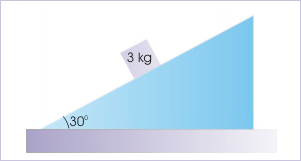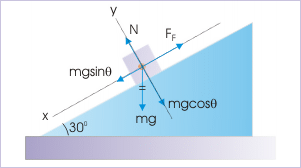| << Chapter < Page | Chapter >> Page > |
Questions and their answers are presented here in the module text format as if it were an extension of the treatment of the topic. The idea is to provide a verbose explanation, detailing the application of theory. Solution presented is, therefore, treated as the part of the understanding process – not merely a Q/A session. The emphasis is to enforce ideas and concepts, which can not be completely absorbed unless they are put to real time situation.
We discuss problems, which highlight certain aspects of the study leading to motion on rough incline plane. The questions are categorized in terms of the characterizing features of the subject matter :
Problem 1 : A block of mass 3 kg is placed on a fixed incline of angle 30°. The coefficients of static and kinetic friction between the block and incline surface are 0.7 and 0.68 respectively. Find the friction acting on the block.
Block on an incline

Solution : In order to know friction – its magnitude and direction, we need to compare component of external force parallel to incline with the limiting friction. Here, only gravity acts (other than friction) on the block. The component of gravity parallel to incline is :
As gravity is the only force pulling the block down, friction acts up as shown in the figure.
Block on an incline

The limiting friction is :
It means that pulling force due to gravity is less than limiting friction. Hence, friction is equal to static friction, which is equal to pulling force. The friction, therefore, is :
Problem 2 : An incline has upper first half of its surface perfectly smooth and lower second half of its surface rough. A block beginning from the top of the incline exactly stops at the bottom of the incline. Find the coefficient of friction between block and lower half of the incline.
Solution : It is clear from the question that the block accelerates at constant rate in the first half and decelerates at constant rate in the second half of its journey over incline. Further, the journey is divided in two equal halves. The block comes to rest at the bottom of the incline. It means that block decelerates in the second half at the same rate at which it is accelerated in the first half.
Let “a” be acceleration in the first half. As there is no friction in the first half, acceleration is equal to the component of acceleration due to gravity along the incline.
In the second half, friction comes into picture. As relative motion between surfaces is involved, we conclude that friction is kinetic friction. The free body diagram of the block for the motion in second half is shown in the figure.

Notification Switch
Would you like to follow the 'Physics for k-12' conversation and receive update notifications?